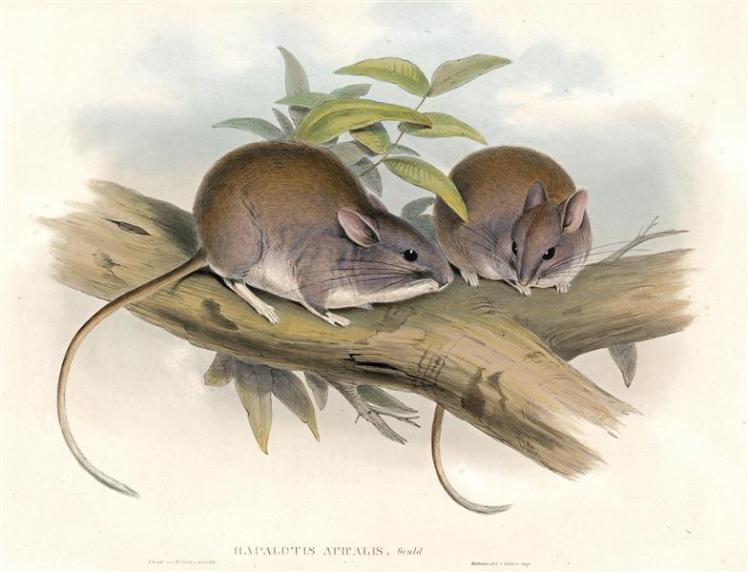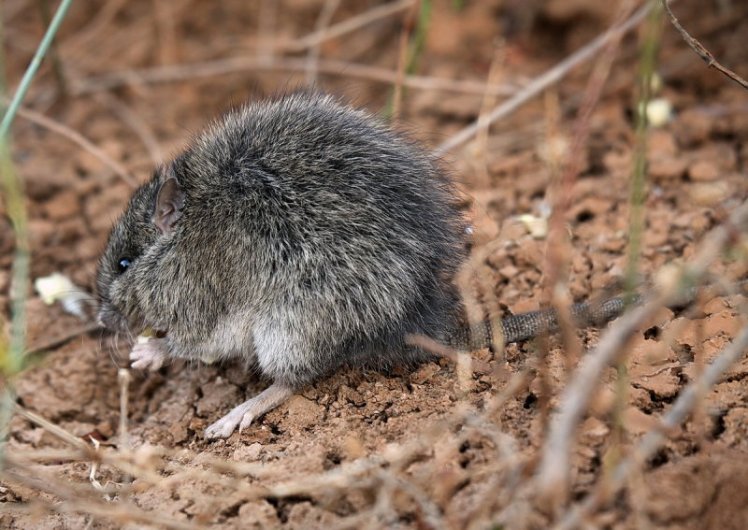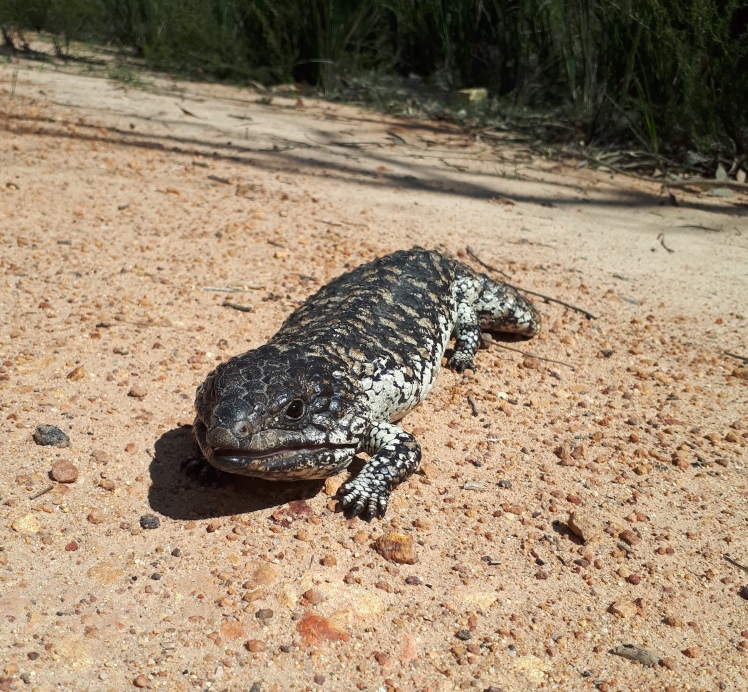I love mice. Native mice. Tiny little fluffy bundles of joy, looking out of traps at me with sleepy eyes, peeved that I’ve woken them from their cosy slumber with their belly full of peanut butter and oats. Mice climbing onto my hands, running up my arms, then leaping off onto the ground, pausing to preen and rehydrate by nibbling a green leaf or sipping water off of another before bounding away to their burrow to sleep for the rest of the day.

“You mean field mice?”
“Oh, like the marsupial mice?”
There have been a few posts doing the rounds lately about dropping the words ‘rat’ and ‘mouse’ from the common names of our native rodents; pandering to the idea that no one wants to help conserve our native rodents unless we can trick them into thinking that they’re marsupials. Australia is too pure and special to have native rats and mice. A landscape that can produce the platypus surely wouldn’t stoop so low as to have churned out 65+ species of rodent. Gross.
Oh, but it did.
The Australian landscape has done a fantastic job of nudging rodent speciation along over the past 5 million years or so. The Australian people have done a similarly fantastic job of wiping out those rodent species over the last 200 years. Since Europeans rocked up, we’ve lost at least 14 species of rodent. Cool ones too, like the Lesser Stick-Nest Rat and a bunch of hopping mice. Not that a species needs to amuse or delight to be worthy of existing.

Of the 50 or so Aussie rodent species still hanging on, roughly half are still suffering major declines because of us. We’ve trashed their habitat, building on it, cutting it down, digging it up, letting our hooved livestock trample it. We’ve brought in cats and foxes – both great rodent killers – into a landscape where the rodents, though delightful, aren’t always clued on to how to avoid becoming dinner. And now we’re contemplating denying their identity in order to trick people into caring about them.
Yes, we have invasive rodents here too – the kind that make people squirm when I say I work with mice. House Mice (or Field Mice as some Aussies like to call them), Black Rats, and Brown Rats – all brought over here with Europeans in the last few hundred years. Those are the ones you hear in the roof or see at the train station. The ones found in plague proportions in agricultural areas. The ones that ate all the plastic bits out of my car engine.
Three introduced species sullying the rodent name for all 65 Aussie natives.
Admittedly some native rodents may cause a bit of a hassle for humans occasionally – the Long-haired Rat (Rattus villosissimus), for instance, can go through periods of extremely high abundance. However, you will never even see most of our native rodent species unless you’re out in the bush trapping for them or spotlighting in the desert. Even then it can be a struggle to find some species.

Nevertheless, they’re rodents. There’s no two ways about it, and there’s nothing wrong with it. Rather than pretending that Australia isn’t home to an amazing array of native rats and mice, perhaps we could embrace them. Rather than assuming that the general public are incapable of interest or compassion for rodents, perhaps we could explain the difference between the idea in their head of ‘rats’, and the reality of rodents being a group of more than 2000 species worldwide. Treating the words ‘rat’ and ‘mouse’ like they’re toxic just helps to perpetuate the myth that these species are lesser. When really the only lesser one is Leporillus apicalis – the Lesser Stick-Nest Rat.
Using Indigenous names for our native rodents is a different story, and a far more complicated one. It’s a nice, logical idea. They had names before scientists named them, and it would be respectful to acknowledge that and to use them. However, most of our native rodent species have ranges that cross multiple language boundaries, so to formalise it you would end up having to choose one name for a species to the neglect of others. Using them informally is not as big a deal as it seems, as many species already have multiple regional common names; what I call a stumpy tail lizard is also known as a shingleback, bobtail, boggi, pinecone lizard, or sleepy lizard depending on where you are. Although the more names you add, the more confusing it can be and the less likely it is that people will know what species you’re talking about.

well said Phoebe, I agree with you regarding common names.
LikeLiked by 1 person
Thanks, Peter!
LikeLike
Very well written. So cleverly informative even an American could grasp your lesson. Although I suppose I will now have to learn real Aussie dirty words now. . .
LikeLike
I don’t know if I am too late to ask a question on this forum but hope not. I noticed a rodent in my garden yesterday – looked different from common house mouse, not big enough for a rat but a little bigger than a house mouse. It went quickly so I had not much chance to observe but it seemed to have a founded back indicating larger haunches, was greyish and moved somewhat erratically. I am in Surrey Hills – 16km east of Melbourne CBD. We have pockets of bushland nearby. What could it be?
LikeLike
I don’t know if I am too late to ask a question on this forum but hope not. I noticed a rodent in my garden yesterday – looked different from common house mouse, not big enough for a rat but a little bigger than a house mouse. It went quickly so I had not much chance to observe but it seemed to have a rounded back indicating larger haunches, was greyish and moved somewhat erratically. I am in Surrey Hills – 16km east of Melbourne CBD. We have pockets of bushland nearby. What could it be?
LikeLike
Hi Carole,
Always happy to help with rodent identification!
Judging from the size and location, your little visitor was most likely a young Black Rat. They aren’t native to Aus, and are the annoying ones that people get in their roofs. If it was moving erratically (and out in the daytime?) it may have taken some poisoned rat bait. If you see it again and happen to get some photos, I’d be happy to take a look and confirm the ID.
Cheers,
Phoebe
LikeLike
Hi Phoebe, I was out in my garden in Doncaster (Melbourne) when I saw a small black mouse which hopped. Not up on it’s back legs but kind of in small bounds. It didn’t move like one of those lightening fast house mice. It also ran for cover under some cut branches in the garden. Not usually the direction house mice usually run. Do you have any suggestions?
LikeLike
Hi Jacqui,
It sounds like it might be a young Black Rat. Based on your location it was likely a Black Rat or House Mouse, both of which move in those hopping-like bounds when they’re in a rush, and are invasive species. Black Rats are highly varied in colour, usually brown but can be black, whereas House Mice are rarely that dark outside captivity. Did you get a glimpse of the tail? If it was quite long compared to the body, it was almost certainly a Black Rat.
Cheers,
Phoebe
LikeLike
Thanks Phoebe.
LikeLike
We definitely have native mice I believe, they hop away like little kangaroos. Will it kill them if we relocate them? I trapped one today in a live mouse catcher and relocated it one km away in a national park. Is it doomed?
It looks exactly like the picture I clicked on that took me to this page.
LikeLike
Hi Rachel,
Do you have any photos of the mice? You can send photos to nativemouse.id@gmail.com and I’ll see if I can identify them for you.
Thanks,
Phoebe
LikeLike